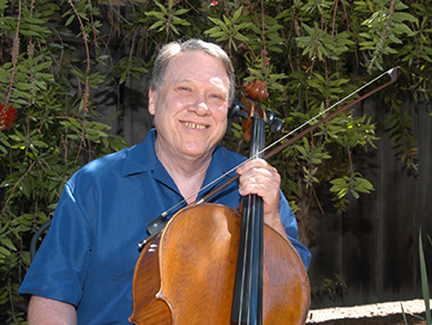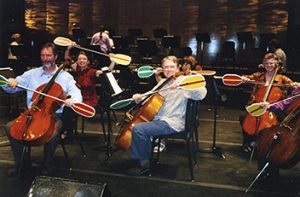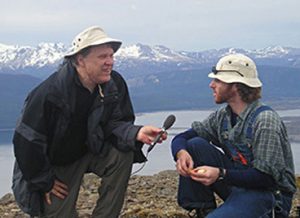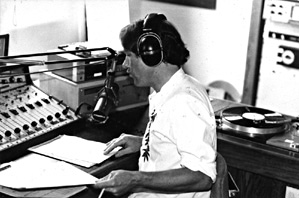
“My mother used to say, ‘Roger, I wish you would get a real job.’ And I used to say, ‘Mother, I have five jobs.’”
Roger Emanuels is a cellist, pianist, educator, radio broadcaster, Local 6 Life Member, and world traveler. He played for many years with the San Jose Symphony and taught privately in Mountain View.
Roger Emanuels was born in 1941 in San Mateo, CA. The youngest of four children, he grew up on his great grandparents’ walnut orchard in Walnut Creek. As a child Roger was fascinated with the family piano and begged his parents for lessons. An avid 4-H member, he raised money by selling chickens and eggs to his neighbors to fund his growing record collection. “LPs were new at the time. My first LP was a Lalo Cello Concerto.”
Roger started on cello in school when he was 10. A few years later, the San Francisco Symphony and Opera (which were combined at the time) performed an outreach concert at his school consisting of scenes from The Marriage of Figaro, in costume, with a small ensemble. Roger was transfixed. “I thought, ‘Oh my God, listen to this!’ I’ll never forget that experience. It was just one afternoon, but it had a tremendous influence on me.”

Roger in 1959.
When he was 15, Roger decided he needed a better cello. His parents balked at the idea, but Roger insisted and spent that summer driving a tractor to pay for it. “I didn’t know anything about buying a cello, but it was shiny, and new, and I thought it was wonderful.” Encouraged by his high school teacher, Roger was accepted into Oberlin in 1959. In his first class his professor took one look at Rogers cello and said, “We have to do something about this.” Though shocked at the news, Roger’s parents agreed to help him buy a decent instrument.
When he graduated in 1964, rather than going directly to graduate school, Roger joined the Peace Corps. “Many students, including myself, were so moved by the death of President Kennedy that we felt the need to do something. It affected a lot of people.” In the Peace Corps, Roger says there were two ways to get involved. One was to pick a geographical area, and another was having a specific skill. “I told them I was a musician and had to stay in my field. Luckily, there was a two-year position as a cello teacher at Austral University in Valdivia, Chile. I remember visiting my new friends in their homes in Chile and was very moved because they would often have a picture of Jesus Christ, and President Kennedy, side by side.” Besides learning about a whole new culture and language, this period was very helpful to Roger because it gave him time to develop his playing skills. “Being a late starter, I was not on top of my game technically.”
During his second year in Chile, Roger won a scholarship to the Paris Conservatory. He was thrilled, but after a few months of classes realized he needed more structure, and he was running out of money. He returned to the US and went to graduate school at Indiana University where he studied with Fritz Magg. After graduation, Roger was hired for a combined teaching and orchestral job at the University of Evansville in Southern Indiana.
In 1972, Roger landed a non-tenure job at the University of California, Santa Cruz, as a cello and theory teacher. He settled in Santa Cruz and eventually bought the house he was renting, which he lives in today. “At the time I wondered how I was ever going to pay the $250/mo. mortgage as a freelancer, but things worked out.”

Roger with The Cabrillo Festival Orchestra cello section in 2005 as they perform their annual prank—pulling out their props after the performance of Kevin Put’s “River’s Rush”.
Along with teaching private students and freelancing as much as he could, Roger became principal cellist in the Monterey and Santa Cruz Symphonies. “This was back in the day when they were happy to have a professional sit in. When I finished the audition for Monterey I asked them if they wanted me to play with them and the manager said, ‘Yes, we’d like you to do the whole season.’” When his teaching job ended at UCSC, Roger worked with an opera training group in Carmel Valley. “I helped to form a little orchestra to play in their operas. I played in it and managed it for two years. By then it was 1980 and I had won a position in the San Jose Symphony under George Cleve.”
“George Cleve was really great to work with. He had a reputation of being very difficult, which was true, but he was a dependable conductor and a total musician. We all learned a lot.” This was Roger’s first experience working under an established CBA. As the Symphony expanded and added more concerts, Roger became active in the negotiating committee and created a newsletter for the musicians, a new idea promoted by the AFM to facilitate better communication within CBA groups. Roger says the biggest concern at the time was to get the pension contributions up. Now spending more time in Silicon Valley, Roger rented out his house and moved to Menlo Park for a few years where he established a teaching practice for children and young adults.

Roger conducts a radio interview with a scientist on the Beagle Channel, Chile.
One of the most significant things that happened to him didn’t have anything to do with playing music. In the early 70s he volunteered as a DJ at KUSP, a public radio station in Santa Cruz. His friends hosted a Latin American folk show and invited him to fill in because he had been there and had a record collection. “After that first experience, a classical music program became available. I took that and did a weekly radio show for 32 years. People began to recognize my voice. I’d be out shopping and someone would hear me speaking and they’d say, ‘I know you.’”
By the 1990s, orchestras were trying new approaches to catching the interest of their audiences. Aware of his growing notoriety as a radio broadcaster, Roger was asked to do pre-concert talks for the San Jose Symphony. “Only one orchestra had tried that. I co-hosted the talks with principal violist, Ken Harrison. Our goal was not to be musicologists, but to present it as players in the orchestra. We’d bounce off each other with a sense of humor, and the crowd loved it! The talks became hugely popular. We would draw in about 10% of the audience, around 200 people. When I left the symphony, other organizations began asking me to give talks. Now I do talks for the San Jose Chamber Society, the Steinway Society in San Jose, and various other things.”

“KUSP would send out a team to broadcast local concerts and I would be the announcer for them. I also traveled all over the Bay Area to interview guest artists, conductors, and composers. Over time I was producing over 70 concert broadcasts a year.”
When the San Jose Symphony went bankrupt in 2001, Roger continued playing with the newly formed Symphony Silicon Valley until his retirement in 2009. “For the last concert I played, George Cleve was the guest conductor. The program was Brahms and Dvorak—I thought, ‘This is exactly what I want to go out with for my last hurrah on that stage.’”
In retirement, Roger continues to play in various ensembles with other Local 6 members, including a cello duo with Louella Hasbun, and a piano duo with Carol Panofsky. He teaches a few students when he has time and gives talks for various organizations. He is currently making plans for his first trip to Italy.

Roger on one of his many adventures in Chile. “I try to come back every year. Because I learned Spanish with a Chilean accent, people often ask me where I’m from. They’re always surprised when I say the United States.”
Roger says the big question he had when he left the orchestra was: “What will it be like to never play a Mahler symphony again, to never play a Brahms symphony again? Can I do that?” It didn’t take long for him to find the answer. “I found that I could listen to those pieces and it would awaken the same thing in my brain. I knew what was coming next and I would be fulfilled when it happened. And I could experience it time and time again without having to do the heavy work.” Roger also found himself spending hours a day studying Spanish, French, and Italian. “Playing music and studying language are really the same process. You’re using your ear, trying to make the sounds a little better to get some meaning out of it. That’s what music is.”
